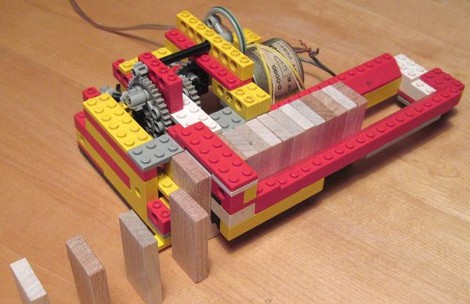[Mattias] brings the awesome once more with his LEGO robot that sets up dominoes. You’ll remember his work from the wooden keyboard case and the mechanical binary adder. This time around he’s still exercising those woodworking skills by making his own domino tiles, but it’s the robot that makes this interesting. In the must-see video after the break the device lays perfectly straight, perfectly spaced dominoes just begging to be upset by a spoiled toddler. The robot is nothing more than handful of LEGO parts powered by a tape deck motor. The parts may be meager, but there’s an abundance of ingenuity tied up in the design.
LEGO Book Scanner

Here’s a good one from a few years back. [Muranushi] built a scanner to automatically scan an entire book. LEGO is used as the primary building material. A book is placed on a LEGO balance (inset photo) with a counterweight that eases the work of raising and lower the book. The book is lowered, a LEGO carriage moves across the book to turn the page, the book is raised to the glass of an upside-down scanner and scanned into a laptop.
It seems LEGO and imaging devices are a great match. Most of the parts used here are from LEGO Technical set 8485, a set that comes with motors and a motor controller seen above, on the floor behind the computer. We’ve embedded some video after the break of a book in the midst of the scanning process. Continue reading “LEGO Book Scanner”
Broken TV Brought To Life In LEGO Body

After letting it sit around for about 3 years, [Blake] decided it was time to fix his broken 15″ television. A little trouble shooting showed the problem was with the inverter. The backlight would come on for a few seconds, off for a few seconds, then repeat. By freeing the Magnavox 15MF400T from its metal case he got it working again, but couldn’t find the source of the short. His solution: build a new case out of non-conductive material. Voilà! We have the 15″ LEGO monitor.
It’s not a very complicated LEGO build, but it’s the first case mod we’ve seen in a long time that isn’t strictly gratuitous. Join us after the break for more pictures. Continue reading “Broken TV Brought To Life In LEGO Body”
Pick-and-place Lego Prototyping
[youtube=http://www.youtube.com/watch?v=Ps59Hj9RIG0]
[Ned] tipped us off about his project for a class at Carnegie Mellon. Utilizing a Denso 6-AOF robotic arm they have built a rapid prototyping machine that uses Lego as the building material. LDraw, the open standard Lego CAD program, is used to build a model which is then translated into MATLAB files that the robotic arm can use for placement commands. Right now pieces need to be placed on a template for the robot to find and pick up.
It’s great that Lego pieces are used because they are readily available and inexpensive, but this type of precision robot makes the project unattainable for most tinkerers. Still, the concept is interesting and we could see an end goal being a more widely available machine. It’s not too much of a leap to image a RepRap type machine that takes internal measurements of a circuit board and the components, calculates inside case dimensions, then builds a prototype enclosure from common Lego pieces.
Rotating Lego Dock Take Two

Last week we saw a rotating iPhone dock built from Lego. This week we’re happy to put up another example of a dock made of these popular building blocks. Thank goodness this one takes into account all of the sudden jolts that our desk is prone to by incorporating shock absorbing springs. The design is very sleek with a jazzy red scheme and a less-is-more attitude. We are a bit concerned about our expensive hand held falling out but then again that’s what the springs are for. Who can be the first to put together a step-by-step guide for building this one?
[via Engadget]
Rotating IPhone Dock From Legos

Hot on the heels of the aluminum dock and the Lego camera mount, [Steve] sent in his iPhone/iPod Touch dock made out of Lego bricks. It’s very stylish with a black and grey theme but we think the function makes this DIY spectacular. In the design [Steve] has included the ability to rotate the cradle so that the iPhone can be presented either vertically or horizontally. A step-by-step guide is not yet available but resourceful Lego lovers should be able to build this using his flickr set.
Toyaanisqatsi: Time Lapse Control Using LEGO Parts
[youtube=http://www.youtube.com/watch?v=Fm1fFQfGc9M&feature=player_embedded]
A simple panning motion can add impact to the already-dramatic effect of time lapse photography. To accomplish this, frugal cinematographers sometimes build [Rube Goldberg] contraptions from clock motors, VCR parts or telescope tracking mounts. Hack a Day reader [Stephan Martin] has assembled a clever bargain-basement system using an Arduino-driven stepper motor and a reduction gear system built up from LEGO Technic parts, along with some Processing code on a host PC to direct the show.
While the photography is a bit crude (using just a webcam), [Stephan’s] underlying motion control setup might interest budding filmmakers with [Ron Fricke] aspirations but Top Ramen budgets. What’s more, unlike rigid clock motor approaches, software control of the camera mount has the potential for some interesting non-linear, fluid movements.












